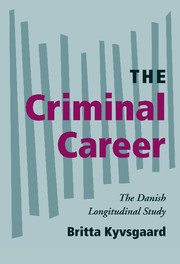Book contents
- Frontmatter
- Contents
- List of Tables
- List of Figures
- Foreword and Acknowledgments
- The Criminal Career
- 1 The Career Concept in Criminological Research
- I Objectives, Methodology, and Sample
- II The Criminal Career
- 7 Prevalence
- 8 Individual Crime Frequencies
- 9 Criminal Onset
- 10 Recidivism and Duration of the Criminal Career
- 11 Desistance from the Criminal Career
- 12 Specialization or Versatility in the Types of Offenses
- 13 Escalation in the Seriousness of Crime
- III Sanctions and Deterrence
- IV Discussion of Results
- References
- Index
11 - Desistance from the Criminal Career
from II - The Criminal Career
Published online by Cambridge University Press: 09 July 2009
- Frontmatter
- Contents
- List of Tables
- List of Figures
- Foreword and Acknowledgments
- The Criminal Career
- 1 The Career Concept in Criminological Research
- I Objectives, Methodology, and Sample
- II The Criminal Career
- 7 Prevalence
- 8 Individual Crime Frequencies
- 9 Criminal Onset
- 10 Recidivism and Duration of the Criminal Career
- 11 Desistance from the Criminal Career
- 12 Specialization or Versatility in the Types of Offenses
- 13 Escalation in the Seriousness of Crime
- III Sanctions and Deterrence
- IV Discussion of Results
- References
- Index
Summary
a criminal career ceases when an individual commits his or her last offense. Ideally, desistance should not be studied until the offender has died.
In studies such as this, which concern a relatively brief period, the possibilities for studying the desistance of the criminal career are limited not only by the length of the study period, but also by the fact that only a part of this period can be used to focus on desistance, since desistance presupposes a prior activity. The study period must therefore be divided into an activity period and a desistance period.
Since the measurement of desistance theoretically makes even greater demands on the length of the study period than that of duration, relatively few studies of this area exist (see Farrington, 1986).
Measuring Desistance
Desistance is here defined by the absence of registered crime for at least 5 years. Given the parameters of the current study, desistance requires that an offender commit no new offenses after 12.31.1986 and until the end of the study period.
Five years of criminal inactivity strongly suggest that the individual has truly ceased to commit crime. Recidivism studies with long periods of observation show that almost all offenders who have not committed new crimes within 5 years of their latest disposition do not commit crime thereafter (Hood and Sparks, 1970; see also Figure 15.1). As shown in Chapter 8 on frequency, recidivism occurs in less than 3% of the cases after cessation of more than 5 years.
- Type
- Chapter
- Information
- The Criminal CareerThe Danish Longitudinal Study, pp. 138 - 146Publisher: Cambridge University PressPrint publication year: 2002



